|
I was connecting with Liz Stockton of X-Port Paws recently about No Kill philosophies and specifically about how some people say that if we just did ________________ (fill in the blank with one thing) the problem would be solved and all the healthy and treatable animals in our nation's tax-funded animal shelters would be saved. I wish it was that simple. Really. I do. If you are familiar with this blog or my website at all, you know I promote the No Kill Equation and have since I first learned about it almost 20 years ago after reading Nathan Winograd's groundbreaking book: Redemption: The Myth of Pet Overpopulation and the No Kill Revolution in America. The short explanation is that the Equation is a DIY series of programs that work together to help reduce the number of animals entering shelters (while helping the public) and that help animals who do end up in shelters to be placed faster (know of as a shorter "length of stay"). All shelters can and should learn about the Equation and take immediate action to stop the outdated (and I would argue unethical) practice of ending the lives of healthy and treatable animals for space or convenience. There are other ways to function and to the extent any shelter purposefully remains mired in the past, I view that a betray of the public trust. After speaking with Liz, I wanted to address the "If We Just Did This One Thing" theories I hear about most often. Spay and Neuter. Not a week (often not a day) goes by when I do not learn of someone saying, "if people would just spay and neuter their pets, animals would not die in shelters." It is absolutely true that if more people spayed and neutered their pets in any given community, there would be fewer animals in the community which may mean fewer animals entering the tax-funded animal shelter. I know some veterinarians charge hundreds of dollars for the surgery and a lot of people just can't afford that while trying to pay rent and feed their families. We can tell them that it costs more to care for a litter than to just have animals sterilized but that's a hard sell when your kids are hungry and there doesn't appear to be an immediate risk your dog will cause a pregnancy or become impregnated. Access to high volume/low cost spay neuter is one of the 11 elements of the No Kill Equation which helps keep pet populations low which, in turn, reduces intake. In the city where I work, there is a nonprofit spay/neuter clinic that is open to anyone no matter where they live or how much money they make. The city also funds a spay/neuter program for low-income residents so they can have pets sterilized for $5. This program, the availability of the nonprofit clinic and other factors have helped cut the shelter intake at the tax-funded animal shelter in half over a period of about five years. Communities that make an investment in programs like this are getting ahead of the issue by spending to prevent births as opposed to spending to impound, house and then destroy animals. I also support laws that require any animal adopted from a shelter or rescue group to be sterilized. I know there are some animal shelters and rescue groups that transfer ownership of animals old enough to be sterilized who are still intact. For shame. I know this happens a lot and it is irresponsible. The "promise method" some shelters use to try to get people to have animals sterilized after they are adopted seldom works. People may agree to have the animal spayed or neutered and may even sign a document in which they agree to do that. Once ownership is transferred, enforcement of the promise method is practically impossible. People often mean well and plan to have the surgery performed but then other priorities (either financially or based on busy schedules) prevents that from happening. Once ownership has changed hands, the shelter can't just demand the animal be returned and even if someone signed a document promising to have the surgery peformed, it becomes a civil issue to be handled legally, something I have never seen a shelter attempt. Ever. I do not support mandatory spay neuter for owned animals, often called MSN. This is punitive legislation that tries to force people to have all owned pets sterilized. Even in places that have MSN, there are exceptions for breeders, exceptions for people who do not want their pet sterilized on advice of their veterinarian and enforcement is almost impossible. I blogged about this fairly recently and will not cover this same topic in full again. I do encourage anyone who believes forcing people to have pets sterilized (as opposed to making it easy and affordable) to read my blog linked above. If you still support MSN after having read it, feel free to contact me so we can talk about your position. As Nathan Winograd says in his video No Kill 101 (which I share with elected officials often): "for decades, spay/neuter has been hailed as the singular solution to shelter killing, though it alone has never successfully created a No Kill Community. Why? Because spay/neuter focuses primarily on those animals who have yet to be born, leaving the animals already in shelters and who are under an immediate death threat with no protection from killing. In other words, while a significant investment in sterilization can reduce intakes over the long term, and that is important, it is no substitute for saving lives today." Rescues and Transports. There are those who profess that the single solution to end shelter killing is to get more rescue groups to help get animals out of shelters to transport more animals to different parts of the country. I've read a number of blogs recently that say just that. Rescuers are some of the most hard working people in the country and are to be applauded by us all. But for rescue groups, many more animals would die in tax funded shelters than do now. I clash with some people in animal rescue circles because their adoption fees price the animals they are trying to place out of the market (as they try to recoup veterinary costs through adoption fees alone), because they refuse to limit their efforts to a geographic area (in their efforts to help more animals than they can responsibly care for) and because so many of them have such loathing for people. Animal problems are people problems and it really is not possible to help animals without helping people in some way. In progressive communities, shelter liaison with rescue groups is incredibly important and is one of the 11 elements of the No Kill Equation. Rescue release should typically be just a fraction of all live outcomes with the other live outcomes being the result of returns to owner and adoptions. I know some in rescue refuse to adopt animals locally because they say the people in their area are too irresponsible, can't be trusted, etc. I once had a contact who drove dogs about an hour to a pet store location to hold adoption events. When I asked her how she was ever going to connect in a positive way with the people in her own community if she acted like they could not be trusted, she could not respond. When I hear or read that THE solution to keep more animals alive is for rescues to pull most of the animals (in most cases to transport them to other areas) I simply cannot agree. There are cases in which nonprofit organizations with a physical shelter contract with one or more municipalities for animal control and sheltering. Most rescue groups, however, are foster-based and function off of donations and grants with no tax-funded support. Rescue groups cannot carry the burden of life-saving for any community not only because they have a limited amount of space to house animals and limited funds to help animals, but also because doing so enables the failures in leadership that create unreasonable reliance on them exists. If a rescue group in any particular area is pulling the vast majority of animals, what incentive is there for elected officials to take responsibility for how their shelters function and how money is spent? None. I know a lot of people in the rescue community view saving animals as a life calling. My argument is that they should be considered part of the solution and not the only solution. The No Kill Equation is not rescue release, rescue release, rescue release, rescue release, rescue release, rescue release, rescue release, rescue release, rescue release, rescue release and rescue release. I know a lot of rescuers are frustrated now, particularly those who have historically relied on transports to other states to move animals. That became abundantly clear during the pandemic, when receiving states would no longer take animals from the source states. I know there are times when people find an animal on a site like Petfinder located hundreds or thousands of miles from them or otherwise learn about an animal on social media who is located far away and decide to adopt. I do not oppose transport for the sake of getting a specific animal from Point A to Point B for those long-distance adoptions. I do oppose mass transports from source locations to receiving locations where the lives of animals are already at risk. One such example is the pipeline between northern Alabama and Chicago. People may like the idea of saving southern animals from what they consider a fate worse than death by shipping them north. But news flash. There are plenty of animals in Chicago already who need help and importing them from other states only makes it harder to place local animals in need. And when nothing is done in the source location to address the reasons why so many animals need help, it is another enabling behavior. I know thousands of animals are transported from Texas to Colorado every year. Every life saved is a wonderful, positive outcome. But if we aren't doing anything to stop the flow of animals from Texas we are doing a disservice to the people who live in Texas and the animals being shipped north. A contact of mine who is the president of a local nonprofit phrased it this way years ago and I have always remembered what she said: the number of animals needing help is like the flow of water through a faucet. If we ever hope to stop the volume of need, we have to turn off the faucet. Yes, Jane. Stop dog breeding. The third solution I see most often, particularly on social media, is the way to keep more shelter animals alive is to "stop people from breeding animals." I do not discount that the volume of animals bred in our country, particularly commercially, contributes to the volume of animals in shelters. Millions of puppies are born and sold each year; it is a multi-million dollar industry. I am not aware of any study that shows a direct connection between dogs bred in Missouri with dog intake in Florida or Tennessee or California. It is logical to assume, however, that because millions of dogs are bred in the U.S. and are sold on websites and by brokers using creative marketing that appeals to consumers, people looking for a dog to add to their family often buy dogs through those methods like they would by a laptop or a sofa. I've written many times about issues related to the commercial dog breeding industry which I oppose and which is often supported by the rescue community. I have also written about the fact that dog breeding is legal and as much as people chant, "don't breed or buy while shelter dogs die," that is just not realistic. I always encourage people to adopt as a first option; I do all I can to persuade them they can find a great fit for their family and that shelter animals are not damaged. As much as I would never buy a dog from a hobby breeder (someone who breeds dogs on a small scale for the love of the breed) or small-volume breeder, many people do and that is their right. A co-worker of mine recently bought a Jack Russell from a breeder in Georgia. Do I wish he had adopted instead? Of course. But it was his choice and not something I was able to influence in any way. For people who genuinely feel that breeding is an issue in their community and is leading to more shelter intake, I encourage those people to create and advance local legislation that requires breeders to pay fees for their business, that creates standards for those operations, and that provides criminal penalties for failing to adequately care for the breeding dogs and the dogs they sell. I also encourage them to get involved on the state level to advance similar legislation for the sake of not only the dogs being bred, but the people who adopt them to make sure the dogs are healthy (something severely lacking in many dogs bred in commercial operations). Local ordinances that prevent pet shops from importing dogs for sale in a retail setting are also important to keep businesses like Petland from setting up shop; once a store is open and is selling their puppies, it is almost impossible to stop. Fires and How to Extinguish Them. In thinking back about my conversations with Liz, there is one other issue I want to touch on related to solutions to shelter killing. I am aware of people who spend a lot of time traveling around the county to bring awareness to what happens in our nation's animal shelters, who blog on that topic and who post about it on social media. I firmly believe that awareness leads to education leads to action leads to change. As much as people in animal advocacy and rescue circles believe the public should know about what is happening at their local shelter, most people just don't because it is not on their personal radar. It's incredibly important that we let the tax-paying public know what is happening at the shelter in their community so they know what they are paying for while they are, in most cases, blamed for a process that leads to the death of healthy and treatable animals. Only when people know what is happening can they participate in the political process and let elected officials know what they want and expect, perhaps even voting them out of office.
What I take issue with is the functional equivalent of yelling fire in a crowded room. Don't raise awareness - on any platform - to the needless deaths taking place nationally without also providing information and tools people can use to understand how we can change our society related to how shelters function. And without claiming it will just take __________________ (fill in the blank with one thing) to fix systemic issues. Don't yell "fire!" (animals are dying) without also pointing the way to the exits and explaining how the fire can be extinguished (saving animals using proven programs). The solutions have been known for almost 20 years and are available for the taking. The No Kill Equation can be implemented in any community and will always look different from location to location based on resources, challenges and the amount of public support. If, for some reason, you are not convinced the Equation works anywhere it is fully implemented, fine. Then develop or find some other solution that actually works and which does not rely on the "If We Just Did This One Thing" theory. I think you will find that to be incredibly difficult but am capable of learning new things. If someone can convince me another methodology works better than the Equation, I will consider myself schooled. If you live or work in a community where the tax-funded shelter ends the lives of healthy and treatable animals, speak out. Seek better. It may be necessary to become politically active as part of a group to try to "fight city hall." Don't wait for a large national animal welfare organization to come to your area to save the day because that's just not gonna happen. If you don't hesitate to complain about potholes in the road, timing of traffic lights, garbage pick-up and police response i your area, you can (and should) also be clear about how you want your money spent when it comes to balancing public safety with saving the lives of companion animals. Nothing changes if. . .nothing changes. As Margaret Meade once said, "Never doubt that a small group of thoughtful, committed citizens can change the world: indeed, it’s the only thing that ever has."
0 Comments
I was contacted by a friend of mine recently who shared a blog she had seen on social media about myths related to No Kill animal shelters. This particular author said that animal welfare is her life but it was also making her lose her mind. How every unfortunate not just for her related to her mental health, but because she chose to share information that is not accurate. I presume she means well. I also presume she has read information to cause her to be hypercritical of the No Kill movement. There is no shortage of negative information to be found online. Opposition to progressive animal sheltering has existed for decades back to the early 1970s when large national animal welfare organizations (or so they claim) promoted the idea that killing was kindness and there is much opposition even today by organizations like PETA. I reached out to the author to try to start a dialogue with her in hopes of advancing her education. Will it work? I'm not sure. Cognitive dissonance abounds in animal shelter and animal rescue circles and it can be really hard for people to recognize what they believed for years was, well, just wrong. I will not link to the blog here. I originally planned to write a blog to counter most of the author's claims, but ultimately decided that would not help many people. I've decided instead to talk about myths and truths so the information can be used by others as they advocate for animal shelter reform in their own communities. And so they can counter false information when they see it. As the saying goes, everyone is entitled to their own opinion but we are all bound by truth and share one set of facts. I won't cover the myths already addressed in my book because they have already been covered. If you want a copy of my book and are not a "hold it in your hands" reader, let me know and I'll share the pdf with you for free. No money is being made on the book when you buy it from Amazon (you are paying to have it printed ) so I share it as a pdf file often. Shelters exist because of the negligence of the general public. If every member of a community were mindful and responsible, shelters would sit empty. This is not true. Shelters in most states exist related to public safety laws that require a place for animals not vaccinated against rabies to be housed, to house dogs running at large and to house animals in suspected cruelty cases pending due process determinations by courts. The fact that the best shelters also function as animal care facilities and not disposal facilities is a response to public expectations. Just because a dog is found running at large does not necessarily mean someone has been negligent. There are some people who let dogs run loose in more rural areas which is clearly irresponsible; that's a huge problem where I live and I see the results of that every time I get in my car. Most loose dogs are lost or displaced due not to negligence but due to some unforeseen circumstance. Doors get left open by children, gates get left open by contractors, dogs dig under and climb over fences, fireworks startle dogs, vehicle accidents happen and natural disasters happen. Ask Davyd Smith of No Kill Colorado how many times his dogs have gotten loose and he'll tell you his stories. Cruelty cases often end up related to a form of mental illness called "Noah Syndrome" about which I have written before and while these cases are tragic, they often result in no criminal consequences. As for the claim that shelters would sit empty, that is an incredibly naive statement. There will always be animal shelters and they will always be needed for both public safety purposes and to help those animals who either were, or could be, someone's beloved companion. That is what the public expects and I just don't see that changing any time soon. In fact, as time goes by more and more people are learning about animal sheltering and about No Kill philosophies as they seek better use of their tax dollars consistent with public values. Shelters are forced to make hard decisions to remain available to the public, including euthanizing for space. This is not true. The only hard decision any shelter need make it to stop killing healthy and treatable animals while calling it euthanasia and behaving as if there is no other way to function. The cure for the disease that is shelter killing has been known for almost two decades and it is the No Kill Equation, a series of programs that work together (thus, use of the description "equation") to reduce shelter intake and increase shelter output while helping the public instead of vilifying the public. To the extent any shelter has not learned about proven programs to help resolve systemic issues that lead the unnecessary killing of animals, that shelter is mired in a past that has not kept up with public expectations and advances in shelter medicine. Theirs is a betrayal of the public trust. Rescue organizations should not boast about being No Kill. I honestly know of no rescue organization that is NOT no kill. Rescue groups function off of donations and grants. Exceedingly rare is the non-profit organization that receives any type of funding from tax dollars unless that organization is contracted to handle sheltering as is the case in Fremont County, Colorado led by the inspiring Doug Rae. To take on more animals than the organization can actually care for and place would be irresponsible and is a kind of hoarding. Yes, rescue organizations sometimes euthanize animals who are suffering, irremediably ill or present a genuine public safety risk and we should expect no less of them. But they don't end lives as a from of population control killing. Having said that, I am the first to admit that some tax funded animal shelters describe themselves as being No Kill operations when they are anything but. They do so to garner public favor and even donations while at the same time either warehousing animals or ending the lives of healthy and treatable animals while claiming they were "unadoptable" or "aggressive." That is why it is up to all of us who care about how animal shelters operate (or at least about how tax dollars are spent) to learn about how shelters can and should operate so we can see through use of the phrase No Kill by bad actors and call them out of those false claims. Animals who end up in shelters are unwanted, thrown away and forgotten. As explained above, just because an animal enters a shelter does not mean that animals is not wanted, has been forgotten or has been thrown away. When shelters take that type of attitude, the public becomes the enemy when it is that same public the shelter needs to adopt animals, foster animals, volunteer at the shelter and at events and even donated to the shelter. Doing so is totally counterproductive toward the goal of modifying public behavior = helping people make better choices. When the public becomes the enemy, it creates a divide between the shelter and the public being served (or rescue groups and the public) in an us v. them way that is just not helpful. Change comes when you first demand it from the members of your community.
This is not true. Demanding people behave differently presumes they are doing something wrong in the first place. Whether people in shelter or animal rescue circles want to acknowledge it or not, most people give very little (if any) thought to their local animal shelter or how their personal choices affect how shelters operate when it comes to having pets spayed and neutered, making sure pets can be identified if displaced and making plans for someone to care for their pets in the event of their death or some live crisis. It is up to us to help educate the public so they can make better choices that help keep animals out of shelters. A couple of the websites I manage have content for this very purpose. To help people. In places where the shelter went from ending the lives of most animals to saving most lives, the public did not suddenly move away to be replaced by more responsible people. What changed was the culture that the shelter which decided to save lives instead of end them and be seen as places not of judgment but of help and positive outcomes. Think about it. I received a call from an animal control contact of mine that was quite disturbing. It still upsets me just thinking about it now. My contact (we'll call her River for purposes of this blog) was trying to help a citizen who had trapped a free roaming cat, also called a community cat. The cat was believed to have an upper respiratory infection. The city does not have an animal shelter. Thinking she was doing the right thing, River took the cat to the local animal hospital with which the city has a contract. She thought the cat would receive veterinary care, would be kept at the animal hospital for the requisite hold period and she would later be able to make the cat available for adoption or get it to a rescue group. What happened next could not be further from what she expected. A vet technician said the cat had to be euthanized and used a heart stick to end the life of the cat while River stood watching in horror. The veterinarian was not on site; the tech behaved like this was common practice. For shame. It is possible the cat may ultimately have been euthanized. Upper respiratory infections in cats are caused by a virus or bacteria and it targets the upper airway instead of the lungs. Having said that, ending the life of the cat by heart sticking without the cat being unconscious is illegal in this state. The vet tech who ended the cat's life this way should be discipline and should lose her job. River reached out to me because she wanted to know about the legality of what happened and because she didn't want it to happen again. Euthanasia can be part of her job for animals who are genuinely suffering or irremediably ill but not like this. We talked about how she could pivot and find different solutions in the future to help cats with the help of local non-profit organizations and the veterinarians with whom those organizations work. We talked about how cats are part of the ecosystem and how it can be impossible to determine just from looking at a cat if he or she is social to people or feral (although there are some behaviors which make it easier to spot a feral cat). It is easy to tell the difference between a domesticated dog and a wild canine. The same cannot be said for cats. At all. River and I talked about Trap - Neuter - Return as the only humane way to manage community cat populations. I have written about TNR before so I won't go into much detail here. The simple explanation is that TNR is a process in which free roaming cats are trapped, sterilized, left-ear tipped for identification (while they are sedated for surgery) and then placed back into the ecosystem in which they were found to stop the breeding cycle and address problem behaviors (mating, marking and yowling). If you want to learn more about TNR, the sources I rely on most are Alley Cat Allies, Million Cat Challenge, Neighborhood Cats (this is specific to New York but has a lot of wonderful information), this 2013 article written by Dr. Kate Hurley and Dr. Julie Levy and this 2019 presentation by Dr. Hurley called Rethinking the Shelter's Role in Community Cat Management. We have been doing TNR at the office where I work for fifteen years with the help of a wonderful organization called Forgotten Felines. It has made a tremendous difference not just for free roaming un-owned cats but for pet cats. We have a feeder station where cats are provided with food and water 365 days a year and near which we do our trapping. Because our close to a housing community, many of our cats come from that community and are social to people. Once those cats are trapped, they are scanned for a microchip, sterilized, vaccinated and made available for adoption. Some of those cats (like Sky, the blue-eyed car you see here) were seriously injured and were able to get the veterinary care they needed because they were attracted to the food source. Those cats who are not social to people are put back into the ecosystem where they are monitored for body weight and general health. When we see an ear-tipped cat, we know it is part of our small colony. There have been a few cats over the years who were so ill they had to be euthanized. We had a old tomcat we tried to help recently who had an infection that was just too advanced to be saved. As sad as it was that he was euthanized, he knew comfort in the last weeks of his life and he avoided what would have been a prolonged and very painful death. River and I also talked about a newer concept called Shelter - Neuter - Return, a subject about which I have engaged with the experts at UC Davis in California. This is similar to TNR but relates to cats entering shelters and how we best help them. Amanda Newkirk shared the following information with me a few years ago: The vast majority of communities have far more cats living outside than adopters looking to bring them inside. For years we trapped cats, brought them into the shelter, tried to adopt as many as we could and, sadly, euthanized the ones that weren’t so lucky. That is until we found out there are an estimated 60-80 million cats living outside and this strategy for managing cats was not one that was ever going to be successful. In fact, removing a small percentage of cats from an environment has actually been shown to increase the number of animals born during the next birthing cycle. I am contacted often by people who oppose TNR or who just don't understand how it works. Most of the opposition is from people who believe the cats they see outside are suffering or who treat cats as an invasive species that pray on birds and other wildlife and would rather have the cats destroyed. People a lot smarter than me have done extensive studies on this topic and I remain unconvinced that the opposing arguments have merit. Removing cats from areas where they are found creates something called the vacuum effect in which other cats take their place. Large-scale efforts to eradicate cats like have been attempted in other countries have never worked and have often endangered other species. I invite anyone who opposes TNR to educate themselves on the facts and not based on sensationalized media hype or emotional arguments. A good place to start is here. On to how it works. It should be obvious: when cats are sterilized, they no longer produce offspring. But the benefits of TNR go way beyond that because of how the presence of those cats in the environment affect other cats around them. My communication with River led to to revisit Dr. Hurley's presentation from 2019 to refresh on what I had learned years ago. It was time well spent. I encourage everyone who is interested in the well-being of all cats to watch the full presentation. This excerpt gets to the heart of why TNR works and last about 4 1/2 minutes. I was very pleased to see a recent Facebook post from another wonderful organization in our area that focuses on TNR and helping people get their pet cats sterilized. They helped River recently with a feral male cat so she could find her pivot. She did not take the cat to the animal hospital where his life likely would have been ended, perhaps in an unspeakable way. River trapped the cat and took him to a veterinarian who agreed to help. This veterinarian sterilized, vaccinated and ear-tipped the cat with the expenses paid by the local nonprofit. The cat was released back into his habitat to live out the rest of his days. He had healthy body weight and it is possible he will live for many more years and will no longer be the "rolling stone papa" he once was. My personal hope is that this new relationship between River and the nonprofit organization means community cats will get the help the need in a way that is humane and which also helps the community.
Thank you for your compassion, River. Thank you for taking a terrible situation and using it to find a humane solution for the future. Joe and Duncan first met about 16 months ago. Duncan had been found running at large by Joe's neighbor. He was skin and bones and had multiple open wounds on his body. He was impounded in the city shelter where Joe began volunteering to help bathe and care for Duncan. Duncan is a sweet, big goofball of a dog, not unlike a small horse. Man and dog bonded immediately. After Duncan's owner came to reclaim him, Joe was told periodic welfare checks would be made every two weeks. This never happened. Fast forward. Joe learned Duncan was illegally tethered inside the backyard of a house occupied not by his owner but by a relative of the owner, in violation of city laws. I wonder now how very different the rest of this story could have been had the law been enforced and had periodic checks been made as Joe was told they would be. Joe checked on Duncan every couple of weeks and sought help from a local non-profit organization to get a doghouse for Duncan and set up a run line. After months of monitoring Duncan and as the weather turned colder, Joe approached the family where Duncan was kept and offered bedding and food. The offer was accepted. Joe gave Duncan fresh food and water, cleaned up his dog house and put out fresh bedding. Fast forward. During one of Joe's checks in late December, Duncan was no longer in the yard. He learned from the woman living in the house that Duncan had escaped and was impounded in the shelter again. Joe went to the shelter immediately and was assured Duncan would not be returned to the owner. Man and dog were reunited as Joe began advocating to find Duncan a good home. Joe was thrilled to learn that his work with Duncan had paid off and a family with two small children had met Duncan and decided to adopt him. They had spent an hour with Duncan and felt completely safe with him being around their 4 and 7 year-old daughters. Not so fast. Within hours of the adoption, the new family called the shelter for help. Duncan (who had likely never lived inside a house) was jumping and reacting to the ceiling fan. "What should we do?" the family asked. Rather than being given help, the family was told to return Duncan to the shelter which they did. I've never understood this response. Dogs have to adjust. Dogs have to decompress. Dogs have to get used to new experiences, particularly when they have lived outside their whole lives. My expectation is that the shelter would guide the family and not be so quick to suggest they return a dog who may behave the same way in another home in the future. We will never really know exactly what happened next and where the miscommunication happened, but shelter staff were led to believe Duncan had tried to bite a child. When he was returned to the shelter, he was met by staff members who were prepared to deal with an aggressive dog. A catch pole was used. Duncan did not react well. Slow down. As soon as Joe learned of Duncan's return, he dug into what had happened. Bite a child? Not the Duncan he knows. He was able to speak with the adoptive family who explained Duncan reacted to a fan, did not try to bite a child and there was a terrible breakdown in communication. When Joe explained to the mother of the children that a reported bite history could lead to Duncan's death, she went to the shelter to make sure Duncan's record was clear. She engaged with Duncan while he was there and he was reportedly happy to see her. Joe told shelter staff he wanted to adopt Duncan and was told no. Stop. Despite this positive interaction with the former adopter and based on the false report about Duncan's bite attempt and his reaction to the catch pole, Duncan was housed in a back kennel in the shelter not accessible to the public. Staff were afraid of the "aggressive" and "dangerous dog" who had allegedly tried to bite a child. Because of their fear, Duncan spent weeks in a kennel without being allowed outside and with very limited interaction with anyone. He was medicated. A representative from a local rescue group tried to pull Duncan from the shelter so Joe could foster him. The rescuer, who had pulled "behavior" dogs from the shelter before, offered to sign a liability waiver as had been done in the past and was told no. Duncan had been deemed aggressive and was to be "euthanized." Wrong. And wrong What followed to save the life of a single dog was nothing short of inspiring and amazing. Joe would not take no for an answer. He began interacting with local behavior experts Lisa and Jason Maasen from The Grounded Pooch, with veterinarians, with a former city council member and with other advocates in the community to fight for Duncan's life. To help convince city officials that Lisa and Jason had experience working with dogs like Duncan before and had been able to help them, two dozen happy clients wrote letters of recommendation with next to no notice in support of the Maasens. Joe sent email messages, he made phone calls, he sought and attended meetings. He explained that Duncan had been unfairly labeled as aggressive and fought to be able to adopt Duncan himself. With the help of what I began to call Team Duncan and after weeks of effort, Joe was able to convince city officials to allow him to be reunited with Duncan at the shelter under the supervision of the shelter director, the city attorney, and the city administrator to determine if Joe and Duncan could still interact safety toward them leaving the building together. Joe was told the city had never done this before and officials were taking a risk because of Joe's Herculean efforts to save one dog. He was required to undergo a home visit to make sure he was prepared to have Duncan in his home. Plans were then put in place for Joe to visit Duncan in his kennel with people standing by in the event Duncan reacted aggressively so they could intervene. Perhaps only Joe and Duncan knew what would happen next. And it was beautiful. When Joe approached the kennel, Duncan wagged his tail. He was happy to see his friend. Joe was allowed to take Duncan out to a play paddock to be truly reunited. I dare you to watch this and not be affected in some way. Joe took Duncan home that day as part of a foster-to-adopt plan which required him to check in weekly and have periodic home visits. He worked the plan that had been developed to integrate Duncan into his home with his other dog and his cat with ongoing help from Lisa and Jason and made amazing progress. The bond between man and dog prevailed. Joe told me on April 5th, more than 2 months after he took Duncan home, that he was allowed to adopt Duncan. Finally. Man and dog together for the rest of Duncan's life, an outcome about which I am grateful. The lives of dogs are ended in shelters every day under the guise of behavior, using labels like "aggressive" and "public safety risk." I do not dispute that some of those labels are warranted and there are genuine reasons to end the life of a dog who may injure or kill someone. I've seen the results of a dog bite fatality attack, and it was gruesome. We know from decades of animal sheltering, however, that how dogs behave in shelters says more about the shelter than the dog. We also know there are ways to set dogs up for success to maximize their ability to be adopted through proper interaction with them, informed kennel assignments and enrichment programs using regular walks, using dog play groups and by providing mental stimulation. We also know that all adopters need adoption counseling, need to be taught about dog decompression and need to be provided with support following the adoption and not just told to bring a dog back who is having trouble adjusting. This can often include common sense guidance and it can include referral to training resources for more long-term solutions.
At one point when Joe was interacting with a senior member of the shelter staff and asked if Duncan had ever bitten anyone of which she knew, the answer was "no. But he might." And therein lies the problem. All dogs have teeth. All dogs bite. They bite themselves; they bite each other, and they use their mouths to communicate. To presume that all dogs are dangerous just because they "might" bite someone is a sure way to end the lives of countless dogs for no good reason at all. And it is wrong. Hundreds of dogs die in shelters like this one every year for issues related to behavior - real or imagined. This particular shelter is currently ending he lives of 1 of every 3 dogs entering the building for "behavior." Let that sink in. More than 30% do not make it out of the building alive. Most are just identification numbers on a report, at least to city officials. They all had lives before entering the shelter, they all had names and they all deserved a chance to be treated as individual lives with value. We will never know how many Duncans are now gone not because they were dangerous but because of failures of a shelter system when solutions are known. This is a tragedy that is entirely preventable but it has to be seen as that - a needless tragedy - for anything to change in the midst of a shelter culture in which this much death is not only accepted but defended. My personal hope is that what happened with Duncan softened some hearts with senior officials with the city and will lead to changes at the shelter. Time will tell. I hold on to happy beginnings like this knowing change comes slowly. And that those who hear the least are those who will not listen. NOTE: This blog references the deaths of two very young children following their interaction with dogs. Some of the content may be disturbing to some readers. Look at the images below of children interacting with dogs. What do you see? Do you see a cuteness overload? These images make me cringe because I see potential danger in the body language of the dogs and the proximity of the children's faces to the dogs' mouths. Two local tragedies related to children does within a period of a week in my area have brought me back to the subject of our unequivocal responsibility to protect dog bite related fatalities. I have written on this subject many times before and believe we just cannot talk about this enough. On February 26, 2024, 4-year old Beau Clark went into a neighbors yard where he was critically injured by a dog. The boy's father tried to intervene and was injured himself. The dog was originally identified by the Morgan County, Alabama Sheriff's Office as a "pit bull." It was later identified as an Olde English Bulldog. The dog was euthanized. The Facebook page for the sheriff's office posted that no charges were filed after the Investigation revealed that:
On March 1, 2024, a 2-year old boy who has not yet been identified entered a fenced yard by opening a gate. He was critically injured by two dogs, a Siberian Husky and a Labrador/Golden Retriever mix, after he was bitten in the face. Details about his prior interaction with the dogs is not yet know. The owner of the dogs (who were taken from the scene by animal control authorities) said they were in their fenced yard, had no prior history of violent or aggressive behavior and had never been out of the yard. He was not home at the time of the incident. Members of the Madison County, Alabama, Sheriff's Office will conduct the investigation into the child's death. These two locations are less than an hour apart. These are compounded tragedies - for the children, for their families, for the owners of the dogs, for the dogs, for the law enforcement community and for the region as a whole. I feel terribly for everyone involved. Local news stations covering these stories have focused mostly on the topic of "aggressive dogs" and what adults can to to keep themselves safe. I saw a story this morning in which a dog trainer was explaining how to use dog repellent spray and how to get into a fetal position to protect your head. I have yet to see any coverage that addresses the issue of keeping children safe around dogs to prevent tragedies like these even though that should be the immediate focus. It is up to all of us to make sure children are safe around dogs - that includes family dogs with whom we share our homes and dogs who belong to others. I've shared information from the CDC and American Veterinary Medical Association about dog bite prevention before but it bears repeating.
The effects of deaths like this are far-reaching and touch even people who do not have children in their home. If you see interaction between a child and dog you feel is unsafe, please intervene before the situation gets out of hand. It is better to anger the dog owner or the adults responsible for the child than to risk serious injury or death. The National Canine Research Council tells us that dog bite related fatalities are extremely rare because they ordinarily are. Not this week in northern Alabama. Welcome to 2024. Last year was difficult for many people for a host of reasons. The world of animal welfare seems to have been turned upside down. This shift began in 2020, but 2023 seems to have been the worst year yet for people who advocate to help animals and people who need help. I personally attribute a lot of this to the pandemic not just because life became harder for many people but because some self-proclaimed leaders in the animal welfare movement seemed to have lost sight of what we all seek - saving the lives of more companion animals and making the world a better place for those animals. Ideas that probably should have been just tossed around after sharing too much alcohol and then discarded as absurd suddenly became operating models for organizations that have a lot of money, influence and power. Those organizations encouraged or provided political cover for animal shelters to:
All of that is the bad news. The good news is that you can make a difference by changing your perspective, something I have had to do myself. How? For me, the key is to focus not on the global issues, issues in a single country or state or issues related to national organizations run amok over which we have no influence, but by trying to make things a little bit better right in our own backyards. I can't use the phrase Dorothy shared in a famous movie because it is subject to copyright, but you get the idea. Focus on the area you consider home. Adopt from a local shelter if you can. Adopting an animal is a 10 to 15 year commitment not to be taken lightly and I know people can only adopt as many animals as they can care for. Please just consider a shelter animal from your community or your region the next time you plan to bring a new animal into your life. Most either were someone's beloved companion and all have the capacity to be just that.
Foster a local animal if you can. Fostering is just as important as adopting. Animals rarely behave in a shelter the way they behave in a home. Fostering an animal from your community allows the shelter or rescue group learn more about the animal's true personality to place that animal faster. For people worried about getting too attached, my hope is you would see your home as a stepping stone to the animal's new future. A step made possible through your generosity. Many rescues are foster-based and the number of animals helped are limited more by the lack of foster homes than by money. Cross-post to be exposure for shelter or rescue animals. I can't count the number of times I have seen people in the shelter and rescue community be critical of people who share about animals in need on social media platforms. They act as if your time is of no value unless you adopt, foster or volunteer. Placing animals is about marketing and the ability to place animals needing homes if limited by the number of people who know about a particular animal. It can sometimes take thousands of shares and comments to get an animal placed. Cross-posting is an important part of that. If someone faults you for now doing more, just laugh. You are helping in your own way. Volunteer locally to help shelter or rescue animals. Even if you can't adopt or foster, most shelters and rescues rely heavily on volunteers. Tasks can relate directly to helping animals like walking dogs, playing with dogs or cats, reading to dogs or cats or transporting dogs or cats to a rescue group or veterinary appointment. You can also help indirectly by helping to market animals, helping admin a social media page, collecting supplies or doing laundry. I spend a lot of time making flyers, doing small fundraisers and making videos in which animals appear to talk or set to music. Speak out to seek better for animals in your community. Most tax-funded animal shelters end the lives of healthy and treatable animals. People are paying for that. If you want better of the elected officials who are stewards of tax-dollars, tell them that. If you learn of neglect or cruelty at your local animal shelter, speak out and demand better. Only when enough people make it obvious to elected officials that issues related to companion animals are important will they listen and either modify their own behavior or be voted out of office. Donate locally to help animals. I know many people who donate to large national groups that claim to advocate for animal welfare while either doing exactly the opposite or while using donations to pay elaborate salaries or administrative costs. I call them the alphabet soup imposters because most are best known by their initials and all are self-perpetuating money making operations. Please don't give them your hard earned money. If you want to donate to help animals, do some research to find an organization in your area where your dollars will do the most good. Donations to municipalities are tax deductible - consider donating to your local animal shelter to cover the adoption fee for a shelter animal to get him or her placed faster or to help pay for extraordinary veterinary care. Also consider donating to help a rescue group in your area. Rescues rely entirely on the goodwill of the public to be able to pay for veterinary care for the animals they help. Animal rescues - please look in your own backyard first. Not a day goes by when I don't learn of someone in animal rescue who has decided to walk away from helping animals completely or who is so angry with the public that it is affecting their physical, mental and emotional healthy. I encourage anyone running a rescue group, regardless of size, to consider what they hope to accomplish using the resources they have. You cannot help 1) all the animals on the planet; or 2) all the animals in north America; or 3) all the animals in the United States; or 4) all the animals in your state. It is my hope that you will look to your own area first when it comes to helping animals in need. Almost every community has animals at risk of having their lives ended at local animal shelters not because there is anything "wrong" with them, but because the way most shelters are managed. Please look to your local shelter first before reacting to all of the social media content about all the animals who need to be placed. That is just too overwhelming and it is up to people in each community to advocate for change in their own areas. Do what you can, knowing it is enough. It is easy to get overwhelmed trying to help animals in need. Something comes across a news feed or someone tags us in a post and we want to do all we can to help. It can be too much on some days for me and I know it is the same for others. When you feel like you just can't take anymore, walk away. Take care of yourself first. There will still be animals in need when you are in a better place and are better prepared to develop a plan for how you can help, if you even can. You alone cannot save all the animals in your community and it in the end, that is not your responsibility. Every small thing you do matters and you will likely never know how the most simple of actions sets other actions in motion. Welcome to 2024. We can all do something to make it better. Animal shelter reform advocacy is tough work. It can consume every day of the week with no days off. It can lead to the loss of long-time contacts and even some people we once considered friends. It can be mentally exhausting as common-sense principles are shared with people who are so personally invested in the status quo that they would rather continue ending the lives of healthy and treatable animals than listen. Just listen. It can be emotionally draining as those intent on defending the killing focus not on the message but on the messenger, as if they are somehow responsible for the fact that the words "please stop killing healthy and treatable animals" have to be said in the first place. I first began advocating for animal shelter reform in 2006 after the loss of our dog Snake. We had her euthanized to keep her from suffering. We know exactly what the word "euthanasia" means so when I learned almost 20 years ago that healthy and treatable animals were being killed in places called "shelters" and they were calling it euthanasia, I knew that was all kinds of wrong. Almost 20 years into this venture, I continue to learn more with the passage of time and I have had my mind changed on some subjects along the way as I have educated myself or been educated by others. I am fully capable of saying, "I was wrong. Thank you for helping me see a new point of view." I have heard before that advocacy to try to reform animal shelters is a marathon and not a sprint. To the extent we talk about national trends, I fully agree with that statement. Times change, people change, values change. In the 1970s, shelters were ending the lives of some 16 to 17 million animals each year. Let that one sink in. 16 to 17 million. By the end of the 1990s that number was down to about 7 to 8 million. It is now less than 1 million animals each year which is still way too many. As is the case with many social movements in our country, change never happens as fast as we would like as it can take decades to see progress. We do best to keep ourselves updated not only on the latest methods being used at progressive animal shelters like the Lake County Florida Animal Shelter and the Humane Society of Fremont County in Colorado (which holds a dozen municipal contracts), but also on how some former leaders in our movement have lost their way and tried to take the public with them. It is hard enough to try to persuade antiquated shelter systems to change. That process is made twice as hard when people lose sight of what works well and instead focus on their own form of celebrity as advocates. Dangerous things can happen for our communities and the animals we love when conversations best shared over too many glasses of wine are instead put forth as viable operational methods. When it comes to local advocacy, I've had a change of heart as it relates to the "sprint not a marathon" description. It is neither, at least in my world. I had my first meeting with the mayor of the city in which I work in January of 2009 after having written to him following the municipal election in 2008. I said, "we can do better" and he wanted to talk about that. When I was not able to affect change on my own after we met, I formed an advocacy coalition in January of 2012. We are in our 12th year of advocacy which has had mixed results. The most intense period of our advocacy began in 2013 after the city refused free help from subject matter experts and we took the issue to the public which was paying attention. We had the attention of the community, a large following on social media and our website and support from local television and print media. We held events, we sold t-shirts and car magnets, we rented electronic billboard space, and we got time on the local public radio station. We were on a roll. That intense period lasted through about 2018 when the city began making changes to the shelter operation and we finally saw improvement in the live release rate which had gone from 49% for dogs and 30% for cats in 2012 to 90% for dogs and 95% for cats in 2018. We knew the city could do even better so our advocacy continued as we promoted our first version of the Huntsville Animal Protection Act and kept pressure on city officials to hold them accountable. The city hit a high for the live release rates at the end of 2021 when the dog live release rate was 94% and it was 96% for cats. We felt pretty good about what we had accomplished even though it had been a very difficult time for all of us balancing advocacy with our jobs and our personal lives. As we feared may happen, the progress achieved was not sustained. The city was able to make some progress by embracing some programs we promoted, but never did fully embrace them all. We now see declines in the live release rate which each passing month. We don't believe a time will ever come when the city reverts to the amount of population control killing it engaged in when I first met with the mayor (33% for dogs and 13% for cats). At least we hope not. We have struggled as a group to stop this gradual decline and have ultimately come to the conclusion that we cannot. We led the horse to water and he had a drink, but he ultimately walked away and nothing we could do could force him to cooperate. We are currently promoting a new version of the HAPA, almost half of which relates to how the shelter makes decisions about "euthanasia" and "behavior dogs" but are not confident it will get much further than a corner of a desk in the city attorney's office. Our communication with members of the city council is more often than not met with replies to the effect that the shelter is doing all that it can to save animals when we know that is just not true. It is easy for any shelter to blame poor performance on the pandemic or the economy or some other issue but those excuses don't work in this particular city that continued to thrive during a 3-year public health crisis, has an incredibly low unemployment rate, was named the top place in the nation to live a year ago and was rated the second best place to live in the nation recently. All advocacy has value, but I have come to believe when it comes to local animal shelter reform advocacy, it is not a sprint or even a marathon. The passage of time takes a toll not only on the advocates themselves, but on the ability of city officials to hear us. In our last meeting with the city administrator last summer, he tolerated us at best and loathed us at worst, in spite of our attempts at diplomacy. Members of the city council who once applauded our efforts have less time - and no doubt less patience - for us as we repeat ourselves over and over, imploring the city to at least try the things we have been recommending in some cases for 10 years. Sometimes I feel like a child in the back seat of a car on a long ride asking, "are we there yet" Are we there yet? Are we there yet?" I stand by what we did because it worked. We were the impetus for change which could have and should have been sustained. I genuinely believe that but for our advocacy, little would have changed and the shelter would still be destroying about half of all animals entering the building.
Local animal shelter reform advocacy is a relay. We have carried the baton for more than a decade as others have tried to beat us with it. I now believe it is time for new voices to be heard whom we hope can build on what we tried to create. We will see the process through with the HAPA. If we can't get enough members of the city council on board after meeting with them for a year, we will have our answer. We know we cannot force the city to change through some form of magical thinking. Sometimes trying hard just is not enough. We wish those who follow in our footsteps the best. All communities are capable of becoming No Kill communities. But not all communities are ready. Enough people have to be angry enough to speak out about what they want from those who govern them and enough elected officials have to be able to listen. Just listen. There are some articles related to the No Kill movement, particularly related to the phrase “No Kill,” which seem to be perpetual. They are shared, reshared and shared again years after the fact. A local contact of mine for whom I have a great deal of respect shared an article from 2021 recently which takes issue with the phrase “No Kill,” makes claims about open admission v. limited admission shelters and which endorses a sheltering philosophy called Socially Conscious Sheltering about which I have blogged before. I asked my contact for the opportunity to speak with her about the article and about SCS and have reached out to her so we can have that conversation. Much of the opposition to No Kill philosophies is founded on false information. It is not possible to respond to every article written in opposition to No Kill philosophies, but there are times when No Kill advocates need to speak out and be clear in an effort to educate the public. That is the purpose of this blog. The article shared by my contact is entitled, “Language Matters: The False Dichotomy of Kill/No Kill.” It was published on May 7, 2021, by Dr. Jennifer Woolf on a platform called VetzInsight. I’ll address just few things that caught my attention which I feel are most important. [The phrase “No Kill is] divisive and unnecessary. I disagree. To me, the phrase “No Kill” is informative. As Dr. Woolf notes in her article, language matters which means words matter. Shelters must use words the same way as they are used by the public. If I seek the help of my veterinarian to end the life of my geriatric dog to alleviate suffering, that is euthanasia. We do not say I killed my dog. If my healthy and treatable dog ends up in an animal shelter and his life is ended, that was not done for reasons of mercy. We cannot possibly say my dog was euthanized. My dog was killed. No Kill means that we don’t end the lives of healthy and treatable animals and that we use the word euthanasia according to the definition. When we call the deaths of healthy and treatable animals euthanasia, we undermine not only the value of those lives but of the lives of animals who were euthanized as an act of mercy and love. When we refer to a shelter as a No Kill shelter, that means the shelter does not end the lives of healthy and treatable animals. I am fully aware there are some shelters that claim No Kill status to garner public favor when they are not No Kill facilities. It is up to all of us to call out that co-option of the phrase "No Kill" when it happens. When people say the phrase “No Kill” is divisive, they are focusing more on the phrase than they are focused on the lives of animals. I fully promote use of the phrase No Kill because it is already on the public radar and it is not difficult to understand. Shelters are not “kill” and “no-kill." They are “open admission” and “limited admission." Shelters are kill and No Kill. If a shelter ends the lives of healthy and treatable animals for space or convenience, it is a kill shelter. If a shelter saves the lives of all healthy and treatable animals, it is a No Kill shelter. The description of shelters as open admission and limited admission has been the subject of much debate in animal sheltering and welfare circles for ages. People behave as if there are only two options: 1) to intake all animals regardless of source or circumstance; or 2) to limit the intake of animals. Talk about a false dichotomy. Many people believe that municipal animal shelters are open admission related to intake not only of animals found running at large (for which the shelter has a public safety function) but also of owned animals. Absent some contract to the contrary, municipal shelters are not obligated to take owned animals and should only do so on a managed basis - which is the third option: managed admission. Christie Keith wrote a blog on this subject years ago that I have shared many times because it is still relevant today. I quoted part of her blog in my book with Christie’s permission: A shelter or animal control agency that responsibly manages its intake flow is still an open admission shelter. Shelters that fulfill the legal or contractual requirements of their municipality as to what animals they are required to admit, and that additionally have provisions for emergency intake for animals in immediate need, are open admission shelters. But some folks simplified [the phrase "No Kill" to mean] stop euthanizing any pets. I have heard the argument many times that people think “No Kill” means no animals die. It is an argument most often used by people who oppose No Kill philosophies, accusing those of us in the no kill movement of advocating for animal suffering. In almost two decades of animal advocacy, I have never met with or interacted with any person who really thinks that shelters keep suffering animals alive and that no animals are ever euthanized. Of course they are. While they are ordinarily only a very small portion of any animal shelter census, there will always be animals in shelters who are either suffering or are irremediably ill for which euthanasia is the only option. The No Kill movement is one of compassion. The notion that animals would be allowed to suffer needlessly is absurd. The Animal Evaluation Matrix to which I have linked here is an extremely helpful guide related to euthanasia decision by shelters. Many municipal shelters are open admission. This means they take in all unwanted animals including the sick, the old, and the dangerous. In many cases, it also means they legally cannot turn away any animal. I personally know of no municipal animal shelter that is required to take every owned animal right this very minute. Cities and counties just don’t function that way. All cities control the amount of property taken from citizens because there are costs associated with those functions. (I know people object to the description of pets as property, but there are some legal advantages to that at this time in our history particularly related the ability of a municipality to seize animals from their caregivers). The word “unwanted” is also not helpful. Just because an animal ends up in a shelter does not mean that happens because no one wants them. More often than not it is because they got loose from the people who do love them and want them. In cases where people seek to surrender their animals to shelters, there are certain some heartless people who do so and should never have had the animal in the first place. The vast majority of people who seek to surrender an animal do so in desperation due to the combination of some life crisis and their inability to see another solution in the moment. When we see animal problems for what they are - people problems - we can help many people keep their pets by providing them with resources to do that or providing them alternatives to surrendering their pet. With regard to animals found running at large, there are some who are dangerous. This is ordinarily a very small percentage of the dogs entering shelters who may have some cognitive issue which causes their behavior to be unpredictable or makes them a genuine danger to the public. This is not the same, however, as dogs who are labeled as aggressive due to behavior created by the shelter environment itself which often overstimulates dogs and in which the people running the shelter expect those dogs to behave the same way they would outside of the building. On the other hand, many private shelters are limited admission. I would go one step further and stay that ALL private shelters, meaning nonprofit shelters which operate on donations and grants using mostly volunteer labor, are limited admission and for good reason. If a shelter receives no funding through tax dollars, has limited capacity to house animals and limited resources to care for those animals, it makes perfect sense to limit admission to just those animals for which the shelter can adequately provide care in order to function responsibly. In order to honor this relationship between open-admission and limited-admission shelters, there is a new movement towards socially conscious sheltering. It eliminates the false dichotomy of kill/no-kill. It suggests that we're all in this together. I have written about Socially Conscious Sheltering before and I will not cover that subject again here in depth. The foundation of SCS is the Five Freedoms that were developed for livestock and while there is nothing wrong with the freedoms in general, the problem is when the lives of animals are ended because the shelter failed to adequately provide an animal with a particular “freedom.” We must also remember the freedoms do not include a freedom to live, absent which the other five freedoms mean nothing. The website for SCS has been updated since I first blogged about this approach four years ago. The website now includes a number of tenants which ultimately achieve nothing because they are the animal welfare version of a political speech. The words look good on a website. They sound good. How could someone possibly disagree with them? In the trenches of animal welfare advocacy where I spend my time, tenants and intentions don’t do much good to keep shelter animals alive. If that is our goal, the solution is known and has been for almost 20 years: the programs and services of the No Kill Equation which can be implemented by any shelter, municipal or nonprofit.
Language matters. Saving the lives of shelter animals matters more. A city official said something to me a while back that got stuck in my head and has rolled around inside my skull like a rock for months. We were talking about the programs and services of the No Kill Equation which I view as the DIY solution to end the needless destruction of shelter animals. As I have written about many times, the genius of the Equation developed by Nathan Winograd almost 20 years ago is that it can be molded and shaped to fit the resources in, and challenges of, any community. We do not need Nathan to travel to every community to help elected officials change the culture in their tax funded shelters. Interacting with progressive shelters to learn from their methods certainly helps, but examination of each element of the Equation to determine how that element can be implemented in the community is the first proactive step towards animal shelter reform. The city official said that he had kept all of the materials we had provided to him years ago about the No Kill Equation with the exception of the publication which talks about how No Kill animal sheltering is cost effective. He said, “I threw that one away years ago because it’s bullshit.” We were taken aback by his comment which probably made sense to him considering how much money had been spent on the shelter operation in recent years. The city had almost doubled the staff from the number of positions that existed when we began our advocacy a decade ago. The city had also spent close to 3 million dollars to renovate the shelter. Our response to him was that having more paid employees was not as important as supervision of those employees and the tasks they perform. We withheld our comments about the renovation of the building because most of the work was completed and us stating we thought money had been wasted would not have advanced the conversation in positive ways. As a resident of Alabama, I do not lack for bad examples about which to write related to animal sheltering. Recent events related to the shelter that spent 3 million dollars on renovations and another shelter building that will soon be constructed reminded me about that rock rolling around in my head related to how money is spent related to shelter animals. This subject is separate from the subject about why saving lives using the No Kill Equation does not cost more about which I will write in the future. What The City Did It’s a given that many municipal shelters currently in operation were built years ago. Most were built to house animals temporarily as part of what we call catch and kill operations in which animals are housed for a limited period of time and are then destroyed. In many cases, it is a “first in, first out” method of operation. There is absolutely nothing wrong with a municipality or community building a new animal shelter that is more suited to progressive operations or renovating an existing shelter for the sake of modernization. Lake County, Florida, became a No Kill Community under the leadership of the county commission and at a time when the shelter was little more than a glorified pole barn. The county now has a new shelter of which it is proud as the county continues to lead the way in No Kill sheltering operation nationally. But some shelter spending is not only unnecessary, it is wasteful. The shelter about which I (and other members of an advocacy group) met with the city official spent a million dollars to renovate the dog kennel area of the shelter. Additional kennels were constructed. The design is a double kennel for each dog; there are two kennel areas separated by a door that can be opened and closed by the staff. As a result of this renovation, the number of kennels in the shelter was actually reduced by 14 kennels. When the city announced the renovations to the community, it touted the changes as improving quality of life for dogs and making them happier. In one media report, it was said the dogs would be “stress free” (a claim we found absurd). The fact that it would easier for staff to clean the kennels was an added benefit to the double kennel construction. The kennel renovation project was completed approximately three years ago, at a time when the dog live release rate at the shelter was 93%. As of the end of 2022, the dog live release rate had dropped to 87%. In 2022, almost four times as many dogs were destroyed for behavior as were destroyed in 2021 (which is almost as many dogs destroyed for behavior in 2019, 2020 and 2021 combined). So much for improved quality of life for dogs who would be happier and less stressed. Most of the dogs destroyed are very young; their brain development and hormones make them ill-equipped to handle the stressors of the shelter environment. What the City Should Have Done (and still can do) As I have marveled at the million spent by the city to renovate the dog kennels (without any apparent positive result) it made me think of how a fraction of that million dollars could have been spent. The shelter sits on a parcel owned by the city. There is a 10-acre rectangular-shaped rural parcel to the south of the shelter which is owned by the city and has been undeveloped for years. The city could easily have cleared an area in the middle of the parcel to construct 2 covered, outdoor kennel structures like the one built in a neighboring county which houses 30 dogs and which is protected by the weather using the same industrial curtains used in the local livestock industry and which roll up and down. The kennels could have been built from north to south and been surrounded by a simple cleared walking path for staff and volunteers to walk dogs during the day in a forest-like setting. At least some of the dogs housed in the shelter all the time could instead be housed outside during the day to provide them with fresh air and the mental stimulation of nature while avoiding the stress that comes from housing them in brick walled kennels inside the shelter. Total cost? Less than 200k for the buildings plus the cost of clearing an oval dirt walking path. For those who object to housing dogs outside, this would be housing during the day for the most part and many of the dogs who end up in the shelter either live outside or spend a lot of time outside unsupervised, which is how they end up at the shelter. And for those who believe outdoor kenneling during the day would require more staff, consider the fact that the staff has already doubled in the last ten years. This is not about more staff; it is (again) about how those people are utilized. The city has already spent the million and more dogs are being destroyed now for behavior than at any time in the last eight years. Now is the time for the City to acknowledge that the spending benefited the staff by making the kennels easier to clean, but did not benefit the dogs. Considering how little it would cost to provide outdoor facilities to house dogs during the day, there is no reason the city cannot consider the outdoor kennel plan for the future. It is also long past time for the city to fully embrace the No Kill Equation and embrace recommendations made over a period of almost a decade to make the shelter hours more family friendly to remove barriers to reclaims and adoptions, to do community outreach to the areas in the city where most dog intake comes from (which is tracked on a map) to reduce that intake do more resource counseling to help people keep pets in existing homes and recognize that the sharp rise in the number of dogs destroyed for behavior is a situation of the city's making which could be avoided by accepting free help from subject matter experts and by changing the approach to dogs who do poorly in the shelter environment. What The County is Doing The county in which I live has never had an animal shelter even though one is required by state law. For years, the county got around the statute by housing impounded dogs at a veterinary clinic for a rate of $10 per dog per day. I tried to get local elected officials to pool funds to have a metro animal shelter to serve the county and all the cities in the county so people only have to go to one place to find a lost pet instead of doing to five places. I failed. When the county finally began making plans for its own facility before the pandemic, I met with elected officials to talk about how the facility would be operated as I again promoted the No Kill Equation. The drawings I was shown to renovate an old building the county had purchased had way too many kennels for the annual intake by the county and I said as much. I also implored the county to get help on how to run a new facility from a subject matter expert for which I offered to raise money to cover part of the cost. The answer was no. The commission chairman was proud of what he called the “No Kill” status of the county, said he did not plan to run for election again and that he considered the new shelter to be part of his legacy in the county. Fast forward three years. The county continued to kennel dogs in the old building which has still not been renovated. It has also been kenneling dogs at a new location (this time a boarding facility) again at a rate of $10 per dog per day. I am told 30 to 40 dogs are housed this way and have been for months. The county has likely spent 100k in the last year just for that long-term boarding (which one elected official called “dog storage”), a situation which cannot be sustained financially. Because county officials say the unchecked spending has to stop, it has decided that any dog in the system 60 days will be destroyed beginning in May, regardless of the health status of the dog. I was told recently that the county will start with the dog who has been in the county system the longest which I’m told is 2 years. To be clear, keeping animals alive is not No Kill and never has been. I am not sure who is responsible for the decision to board dogs long-term but the consequences of that are obvious. Not only is that arrangement not financially sustainable, it creates behavior issues for those dogs, it prevents families from finding their lost dog and it prevents dogs from being adopted by the public. For shame. I am also told the county has committed to spending more than 600k in COVID Relief funds to create a building that is primarily for administrative purposes with some housing for cats but no kennels for dogs. One elected official told me the focus of the building is more about people than about animals. When I asked about the plan to kennel dogs, he could not answer. What The County Should Do
The county intends to spend more than half a million dollars of COVID Relief money on shelter operations. Reserving my personal opinions about the appropriateness of that spending, the money is available for use. I can envision no scenario in which it is appropriate to spend more than half a million dollars on a building that has very little to do with animals and nothing to do with the types of animals that make up the majority of the county’s shelter intake: dogs. So what should the county do with that money? It’s a lot of money and the opportunities are endless. If I was an elected official in the county, these would be my recommendations:
Beyond the spending, the county should also stop using the phrase “No Kill” to mean “we are keeping animals alive.” County officials should learn about the programs and services of the No Kill Equation to help reduce shelter intake and increase shelter output moving forward so it is never in a position in which elected officials sees a mass euthanasia event as the only way to resolve problems of its own making. I have extended an offer to my county commissioner and the animal control officer to begin their education about the No Kill Equation. Time will tell if they are willing to break away from the status quo and mistakes of the past to seek a better future for the residents of the county and the animals with whom they share their lives. I wrote a blog about a month ago about the relationship between animal hoarding and mental health issues that was prompted by realizations about a contact of mine who was found to having dying animals inside her home. I interacted with her family following the suicide of her husband and her death. After learning more about the situation inside the home, I chose to delete the blog and save the topic for another day. This was done primarily out of respect to her family. I told her son I would revisit the issue later and that time has come. I don't expect you to read my blog and agree with me completely. My hope is that you will suspend your judgment long enough to learn something that may serve you well in the future or even help you prevent animal suffering and abuse. Not a week goes by that we don't hear about an animal hoarding situation in some form. Local tragedies have ranged from hundreds of dogs found inside the home of an elderly couple, many of which were dead, to a woman who was found to have dozens of animals on her rural property, many of which were dead or dying. If you search for the phrase "animal hoarding" you will find a litany of news stories from across the country which describe horrific situations which shock the senses. Some cases result in criminal prosecution. Many do not. What the cases have in common is a person or people who have more animals than they can reasonably care for who end up neglecting or abusing those animals leading to suffering and often death. My initial reaction to these situations is the same as most people. The information is disturbing, heart breaking and infuriating all at the same time. How can we not be angry about a situation so out of hand that people and animals live in filth and animals are left to die? How could they be so heartless and care so little for their companion animals? Why didn't they reach out for help? I still have the same initial reaction as I would have had years ago as my focus is on the suffering and death of helpless animals. After almost two decades of animal welfare advocacy, however, my next thoughts look a little deeper to examine the "why" and the "how." I now know these situations for what they are: animal hoarding. When people think of animal hoarding they think of dozens of animals inside a house, perhaps even dead animals inside a freezer. The number of animals is really not important. The complete lack of care for them, despite the best of intentions, is the key. Mental health experts have studied this phenomenon extensively. What at first looks like a criminal act created by intent really is not and the underlying reasons are quite often the opposite. What is Animal Hoarding? This article in Psychology Today explains animal hoarding this way:
How to Spot an Animal Hoarder The following are red flags that someone in your life may be collecting or hoarding animals:
What You Can Do to Help If you genuinely believe someone you know is an animal hoarder, whether you are related to them or not, take action to try to prevent the situation from getting worse.
The Response When I first learned about the abuse and neglect of animals by my local contact, I openly said that I thought there were mental health issues involved. I later learned there were also issues regarding spousal abuse which contributed to the totality of the situation. This was a tragedy compounded by tragedy compounded by suffering and abuse. I ultimately lost long-term contacts when I shared my opinion about mental health problems being the cause of the situation and when I wrote that it made perfect sense in hindsight that my contact was extremely critical of the local animal shelter. The local shelter did not cause her to be a hoarder. It just made sense that she felt so strongly about the shelter ending the lives of healthy and treatable animals while she felt she was doing all she could to keep her own animals alive.
I am always shocked at how much people in the rescue community advocate for compassion toward animals while having none toward people. There are some who are active in animal rescue (but certainly not all) who carry an immense amount of loathing for people in general which is just below the surface of their functioning. Of course animals suffer and die at the hands of hoarders as the hoarders suffer themselves. As much as the torch and pitchfork crowd may want hoarders to pay severely for their crimes, that does not always happen. As is explained by the Animal Legal Defense Fund, "animal hoarding cases are difficult to prosecute [because] most states have no legal definition for animal hoarding, courts already assign relatively low priority to animal abuse and neglect cases in general, and many people are unfamiliar with the severity of abuse in hoarding situations." There is a lesson so many in the animal sheltering and rescue community still have not learned: animal problems are people problems. As terrible as hoarding situations are, they do provide an opportunity for change and to bring good from tragic. I encourage the stakeholders in the animal sheltering, welfare and rescue community in an area in which a hoarding situation is found to examine this issue from a place of compassion and to try to prevent it from happening again. There are some communities that have created a Hoarding Task Force to help address potential hoarding situations using the expertise of mental health professionals, law enforcement professionals and members of the animal sheltering and rescue community. This approach is akin to a shift in some law enforcement agencies from treating every law enforcement encounter with the pubic as a criminal matter and instead using mental health liaisons to resolve situations to avoid arrest, incarceration and prosecution. |
AuthorI am an animal welfare advocate. My goal is to help people understand some basic issues related to companion animals in America. Awareness leads to education leads to action leads to change. Archives
July 2024
Categories
All
image courtesy of Terrah Johnson
|











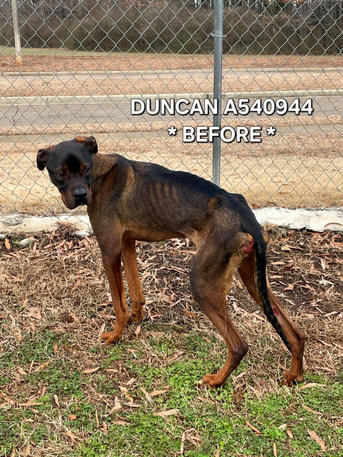

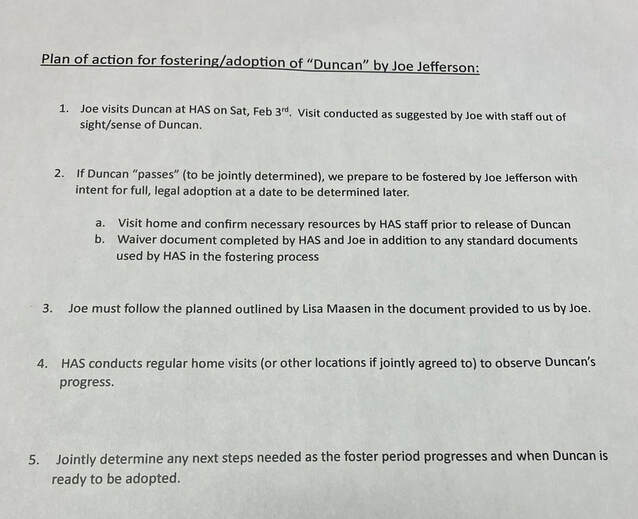
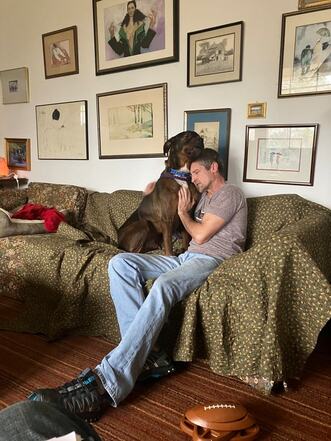
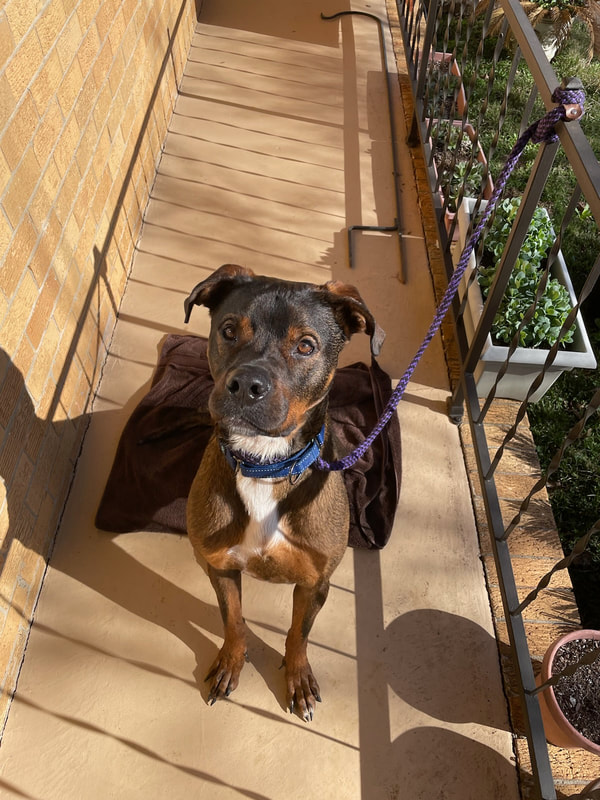
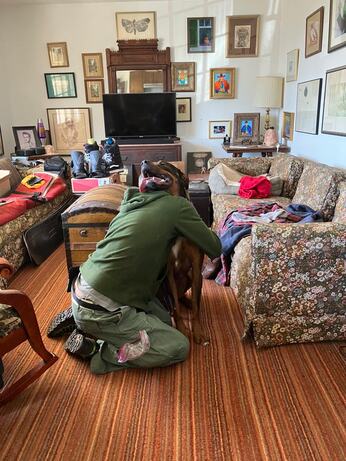






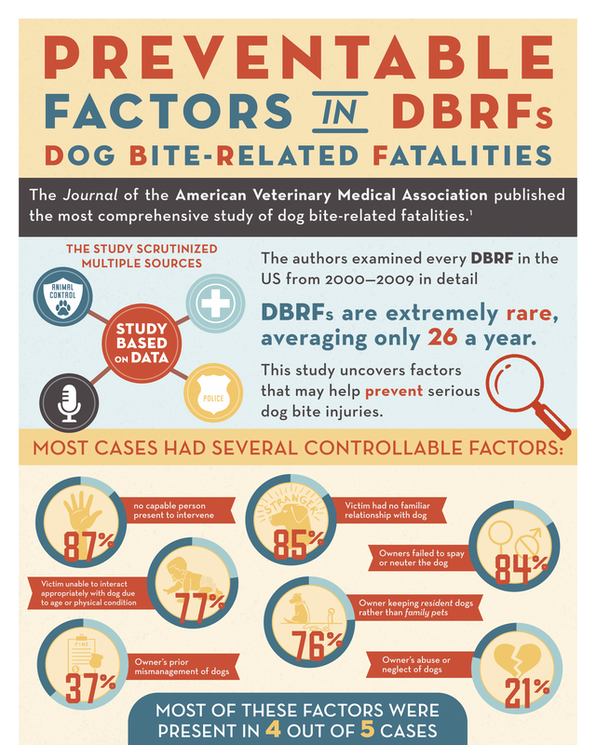

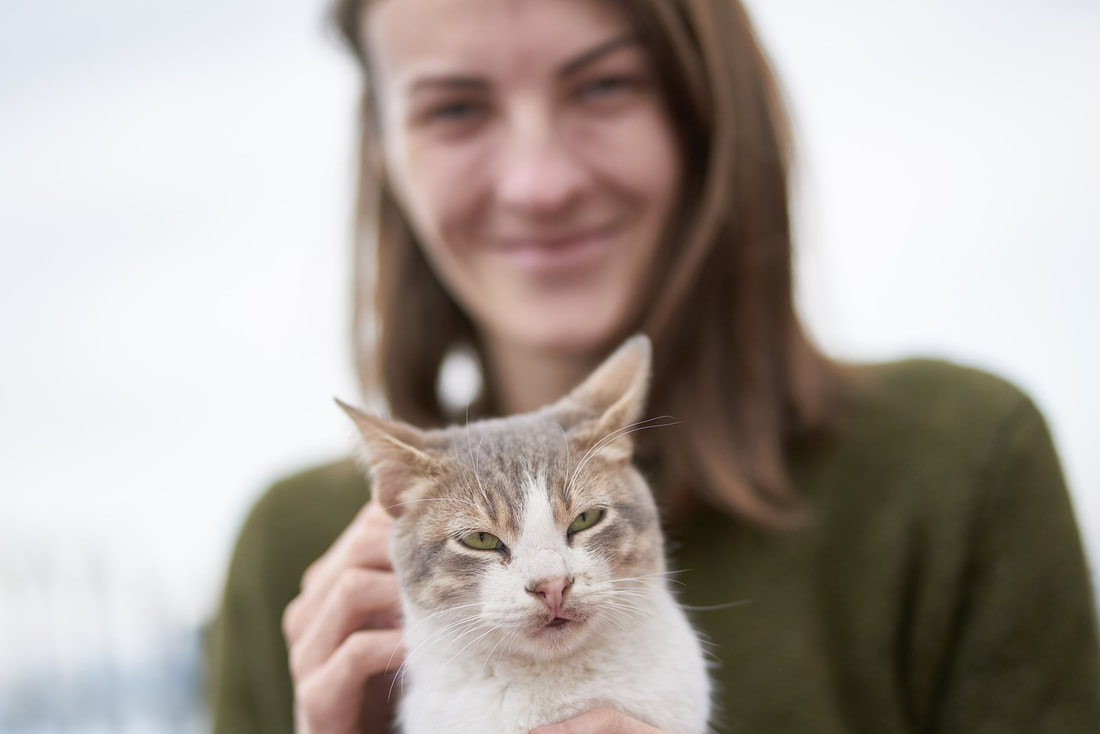
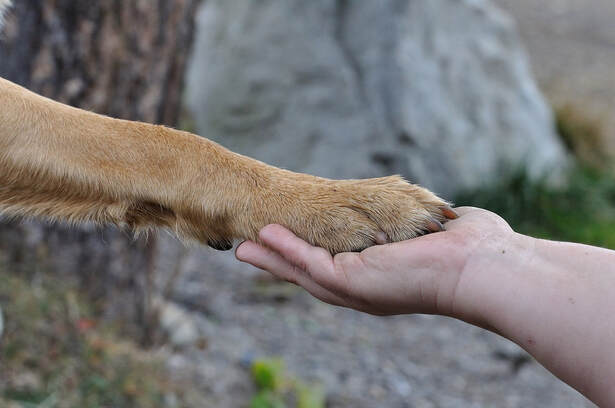

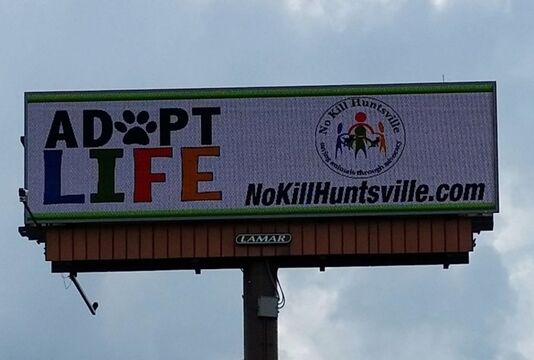





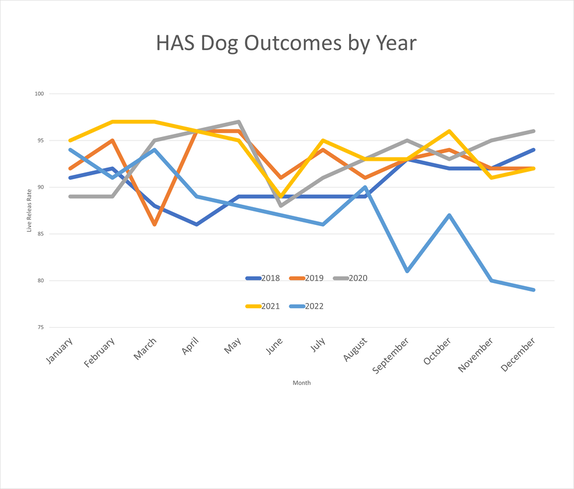
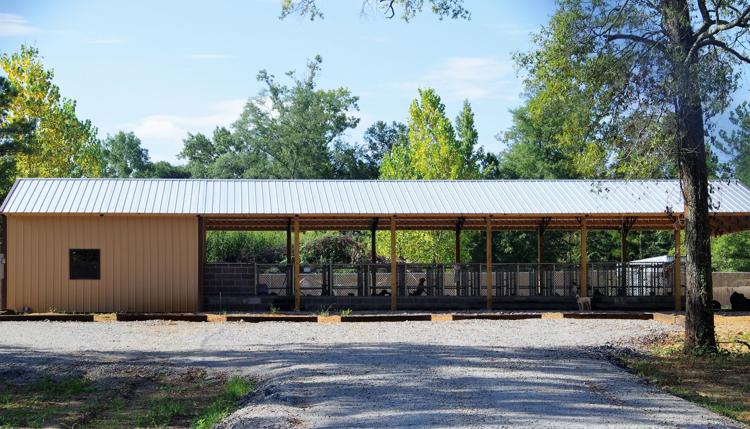
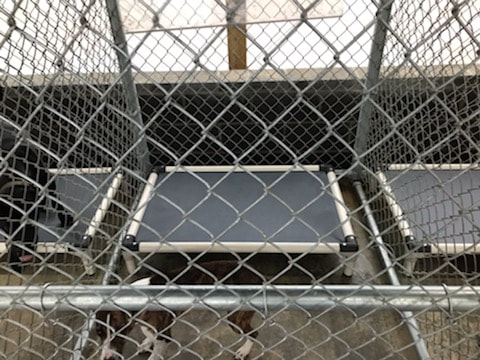
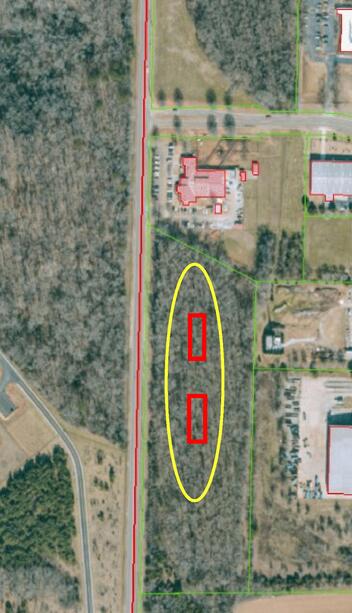
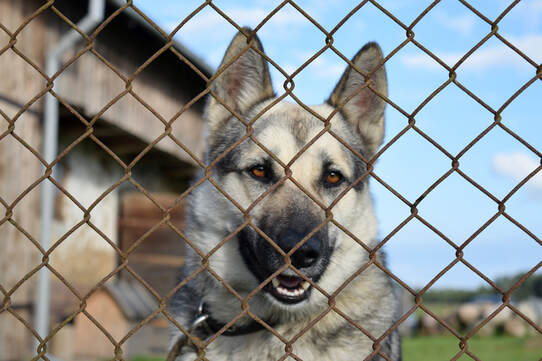



 RSS Feed
RSS Feed